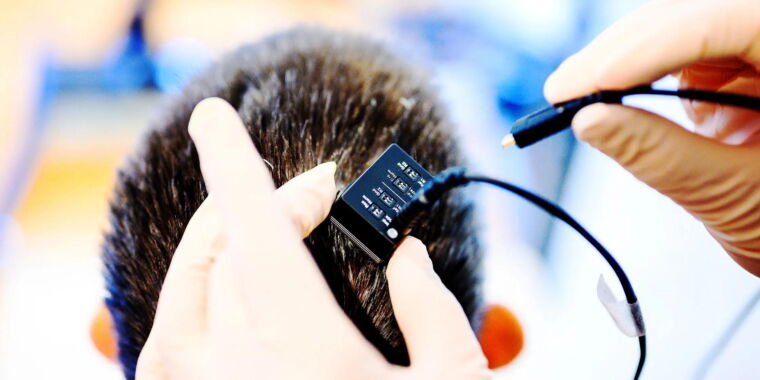
Noah Berger/UCSF
Paralysis had robbed the two women of their ability to speak. For one, the cause was amyotrophic lateral sclerosis, or ALS, a disease that affects the motor neurons. The other had suffered a stroke in her brain stem. Though they can’t enunciate clearly, they remember how to formulate words.
Now, after volunteering to receive brain implants, both are able to communicate through a computer at a speed approaching the tempo of normal conversation. By parsing the neural activity associated with the facial movements involved in talking, the devices decode their intended speech at a rate of 62 and 78 words per minute, respectively—several times faster than the previous record. Their cases are detailed in two papers published Wednesday by separate teams in the journal Nature.
“It is now possible to imagine a future where we can restore fluid conversation to someone with paralysis, enabling them to freely say whatever they want to say with an accuracy high enough to be understood reliably,” said Frank Willett, a research scientist at Stanford University’s Neural Prosthetics Translational Laboratory, during a media briefing on Tuesday. Willett is an author on a paper produced by Stanford researchers; the other was published by a team at UC San Francisco.
While slower than the roughly 160-word-per-minute rate of natural conversation among English speakers, scientists say it’s an exciting step toward restoring real-time speech using a brain-computer interface, or BCI. “It is getting close to being used in everyday life,” says Marc Slutzky, a neurologist at Northwestern University who wasn’t involved in the new studies.
A BCI collects and analyzes brain signals, then translates them into commands to be carried out by an external device. Such systems have allowed paralyzed people to control robotic arms, play video games, and send emails with their minds. Previous research by the two groups showed it was possible to translate a paralyzed person’s intended speech into text on a screen, but with limited speed, accuracy, and vocabulary.
In the Stanford study, researchers developed a BCI that uses the Utah array, a tiny square sensor that looks like a hairbrush with 64 needle-like bristles. Each is tipped with an electrode, and together they collect the activity of individual neurons. Researchers then trained an artificial neural network to decode brain activity and translate it into words displayed on a screen.

Steve Fisch/Stanford University
They tested the system on volunteer Pat Bennett, the ALS patient, who is now 68 years old. In March 2022, a surgeon inserted four of these tiny sensors into Bennett’s cerebral cortex—the outermost layer of the brain. Thin wires connect the arrays to pedestals atop her head, which can be hooked up to a computer via cables.
Over the course of four months, scientists trained the software by asking Bennett to try to say sentences out loud. (Bennett can still produce sounds, but her speech is unintelligible.) Eventually, the software taught itself to recognize the distinct neural signals associated with the movements of the lips, jaw, and tongue that she was making to produce different sounds. From there, it learned the neural activity that corresponds to the motions used to create the sounds that make up words. It was then able to predict sequences of those words and string together sentences on a computer screen.
With the help of the device, Bennett was able to communicate at an average rate of 62 words per minute. The BCI made mistakes 23.8 percent of the time on a 125,000-word vocabulary. The previous record was only 18 words per minute—a record established in 2021, when members of the Stanford team published a paper describing a BCI that converted a paralyzed person’s imagined handwriting into text on a screen.








